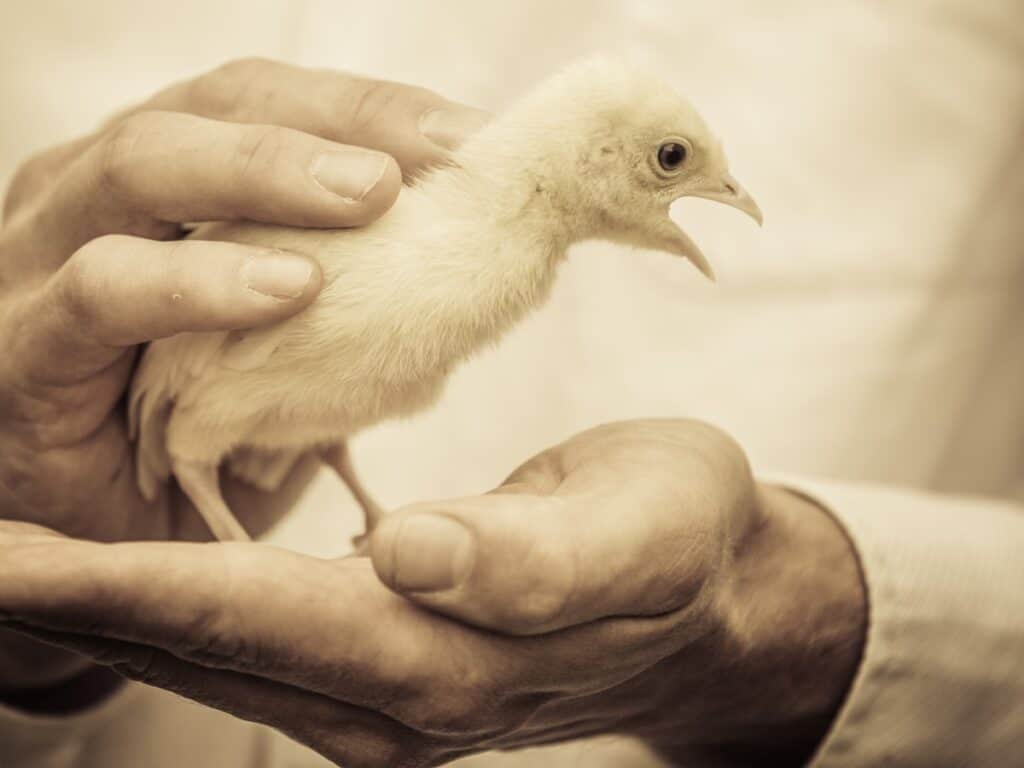As Thanksgiving approaches, many people start thinking about the delicious turkey they will cook for their family and friends. However, have you ever wondered what a baby turkey is called? As a language model AI, I can tell you that a baby turkey is not called a turkey, but rather a poult.
Poults are cute little creatures that are often raised on farms for their meat. They are born in the spring and summer months and are usually kept warm and safe by their mother turkey. While some people may refer to them as chicks, the correct term is poult. Poults are born with a soft, downy coat and are very vulnerable to predators, so they need to be protected by their mother until they are old enough to fend for themselves.
So, if you ever find yourself wondering what a baby turkey is called, remember that it’s a poult. These adorable little creatures are an important part of the turkey farming industry and are a key ingredient in many Thanksgiving dinners. Knowing what a baby turkey is called is just one of the many interesting facts about these fascinating birds.

Naming a Baby Turkey
As a poultry farmer, I often get asked what a baby turkey is called. Naming a baby turkey is not as straightforward as it seems, and there are different names depending on the age and gender of the turkey. In this section, I will discuss the different names for baby turkeys.
What is a Baby Turkey Called?
A baby turkey is called a poult. Poults are young turkeys that are less than four weeks old. The term poult is commonly used in the poultry industry to refer to young turkeys. The word poult comes from the French word poulet, which means chicken. Poults are often sold for meat, and they are a popular choice for Thanksgiving dinner.
Other Names for a Baby Turkey
While poult is the most common name for a baby turkey, there are other names depending on the age and gender of the turkey. Here are some other names for a baby turkey:
- Chick: A baby wild turkey is called a chick. The term chick is also used to refer to young chickens, so it can be confusing.
- Jake: A juvenile male turkey is called a Jake. Jakes are usually less than a year old and have not yet grown a beard.
- Jenny: A juvenile female turkey is called a Jenny. Jennys are also less than a year old and have not yet laid eggs.
- Tom: A male turkey is called a Tom. Toms are mature turkeys that have grown a beard and are at least a year old.
- Hen: A female turkey is called a hen. Hens are mature turkeys that have laid eggs and are at least a year old.
In conclusion, a baby turkey is called a poult, but there are other names depending on the age and gender of the turkey. Understanding the different names for baby turkeys can help you communicate more effectively with other poultry farmers and buyers.
Life Cycle of a Turkey
As I research what a baby turkey is called, I also want to learn more about the life cycle of a turkey. A turkey’s life cycle is divided into four stages: egg stage, poult stage, juvenile stage, and adult stage.
Egg Stage
The egg stage of a turkey’s life cycle begins when a female turkey, called a hen, lays her eggs. She typically lays around 10-12 eggs, which take about 28 days to hatch. During this time, the hen will incubate the eggs by sitting on them to keep them warm.
Poult Stage
Once the eggs hatch, the baby turkeys, called poults, enter the poult stage. At this stage, they are completely dependent on their mother for food and warmth. They will stay close to her and follow her around as she searches for food. Poults are covered in soft down feathers that will eventually be replaced with adult feathers.
Juvenile Stage
As the poults grow, they enter the juvenile stage. At this stage, they start to develop adult feathers and become more independent. They will still stay close to their mother, but they will also start to explore their environment and learn how to find food on their own.
Adult Stage
The final stage of a turkey’s life cycle is the adult stage. At this stage, turkeys are fully grown and have developed all of their adult feathers. They are able to survive on their own and will often form flocks with other turkeys. During the breeding season, adult males, called toms, will compete for the attention of females, called hens.
Overall, the life cycle of a turkey is a fascinating process that takes about a year to complete. From the egg stage to the adult stage, turkeys go through many changes as they grow and develop.
Breeding and Raising Turkeys
Breeding and raising turkeys can be a rewarding experience. As a turkey farmer, I have learned a lot about the process of breeding, incubating, brooding, feeding, and caring for turkeys. Here are some tips that I have found helpful:
Breeding
Breeding turkeys can be done naturally or artificially. Natural breeding involves keeping male and female turkeys together and letting nature take its course. Artificial breeding involves collecting semen from male turkeys and using it to artificially inseminate female turkeys. This method is often used in commercial turkey farming.
Incubation
Once the female turkey lays eggs, they can be incubated in an incubator or under a broody hen. If using an incubator, the temperature should be kept at around 99.5°F with a humidity level of 50-55%. The eggs should be turned at least three times a day. Incubation typically takes around 28 days.
Brooding
Once the eggs hatch, the baby turkeys, or poults, need to be kept warm and dry. A brooder box with a heat lamp or heating pad can be used to provide warmth. The temperature should be kept at around 95°F for the first week and then gradually decreased by 5°F each week until the poults are fully feathered.
Feeding
Baby turkeys need a special diet called starter feed, which is high in protein. The feed should be finely ground and free of medication. After a few weeks, the poults can be switched to a grower feed, which has less protein. Turkeys also need access to clean water at all times.
Care
Turkeys are social animals and should be kept in groups. They need plenty of space to move around and should be kept in a clean and dry environment. Regular cleaning and disinfecting of their living area is important to prevent the spread of disease. It is also important to monitor their health and seek veterinary care if necessary.
Breeding and raising turkeys requires patience and attention to detail, but it can be a fulfilling experience. By following these tips, you can raise healthy and happy turkeys.
Turkey Farming Industry
As a turkey farmer, I have seen the industry evolve over the years. Here are some sub-sections that describe the history, modern practices, and economic importance of turkey farming.
History of Turkey Farming
Turkey farming has been around for a long time, dating back to the early 1500s. Native Americans domesticated turkeys, and European settlers brought them back to Europe. Today, the turkey farming industry is a significant player in the agriculture industry, with production increasing every year.
Modern Turkey Farming Practices
Modern turkey farming practices have come a long way since the early days of turkey farming. Today, turkey farmers use advanced technology to monitor the health and well-being of their birds. They also use specialized diets to ensure that the birds are getting the nutrients they need to grow and thrive.
Turkey farmers also use advanced breeding techniques to produce turkeys that are more resistant to disease and have a higher yield of meat. Additionally, they use environmentally friendly practices to ensure that their farms are sustainable and that they are not harming the environment.
Economic Importance of Turkey Farming
Turkey farming is an essential part of the agriculture industry and contributes significantly to the economy. It provides jobs to many people, from farm workers to processing plant workers. Turkey farming also generates revenue for the local and national economy through the sale of turkey products.
In addition, turkey farming has a significant impact on the export market, with many countries importing turkey products from the United States. The turkey industry is also a significant contributor to the Thanksgiving holiday, with millions of turkeys being sold each year.
In conclusion, the turkey farming industry has a rich history, modern practices that prioritize the health and well-being of the birds, and a significant economic impact. As a turkey farmer, I am proud to be a part of this industry and look forward to seeing how it continues to evolve in the future.
Frequently Asked Questions
What is the name for a baby turkey?
A baby turkey is called a poult. The term “chick” is also used to refer to baby turkeys, but “poult” is the correct term.
What is the term for a young female turkey?
A young female turkey is called a jenny or a hen.
What is the term for a young male turkey?
A young male turkey is called a jake or a tom.
What is the term for a mature female turkey?
A mature female turkey is called a hen.
What is the term for a male turkey?
A male turkey is called a tom or a gobbler.
What do baby turkeys eat?
Baby turkeys, or poults, should be fed a high-protein diet that is specifically formulated for their nutritional needs. This typically includes a starter feed that contains around 28% protein, as well as fresh water. Poults can also be given treats like chopped fruits and vegetables, but these should not make up a significant portion of their diet. It is important to provide poults with clean water and feed at all times, as they have high metabolisms and need to eat frequently to grow and develop properly.
